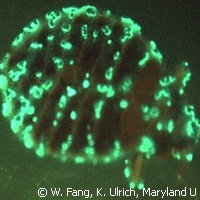Scientists show how transgenic fungi can fight malaria
Virologists the world over continue to investigate measures for fighting malaria, a mosquito-borne infectious disease of humans triggered by the Plasmodium parasite. Now University of Maryland-led researchers from the UK and US have found that a genetically engineered fungus carrying genes for a human anti-malarial antibody or a scorpion anti-malarial toxin could be used to fight this disease. The outcome would be strong and would not harm the environment. Experts say this is good news, particularly as existing pesticides against malaria mosquitoes are losing their lustre. Presented in the journal Science, the findings of this study highlight the fact that this general approach could be used for keeping other dreadful insect and tick bug-borne diseases, like dengue fever, in check. 'Though applied here to combat malaria, our transgenic fungal approach is a very flexible one that allows design and delivery of gene products targeted to almost any disease-carrying arthropod,' explains Professor Raymond St. Leger from the Department of Entomology at the University of Maryland, one of the authors of the study. 'In this current study we show that spraying malaria-transmitting mosquitoes with a fungus genetically altered to produce molecules that target malaria-causing sporozoites could reduce disease transmission to humans by at least five-fold compared to using an un-engineered fungus.' The Maryland researchers, along with their colleagues at the Johns Hopkins School of Public Health in the US and the University of Westminster in the UK, created their transgenic anti-malarial fungus by using the fungus that attacks mosquitoes, called Metarhizium anisopliae, and then inserting into it genes for a human antibody or a scorpion toxin. According to them, both the antibody and the toxin specifically target the malaria-causing parasite Plasmodium falciparum (P. falciparum), a protozoan parasite and one of the Plasmodium species. Next, they compared three groups of mosquitoes heavily infected with the malaria parasite. The mosquitoes in Group 1 were sprayed with the transgenic fungus, while Group 2's insects were sprayed with an unaltered or natural strain of the fungus, and Group 3 were not sprayed with any fungus. Their data showed a significant drop in the number of parasites developed in Group 1 compared with the other two groups. The team said the malaria-causing parasite P. falciparum was found in the salivary glands of just 25% of the mosquitoes sprayed with the transgenic fungi, against 87% of those in Group 2 and 94% of those in Group 3. They pointed out that even in the 25% of mosquitoes that still had parasites after being sprayed with the transgenic fungi, they saw a more than 95% cut in parasite numbers compared to the mosquitoes sprayed with the wild-type fungus. 'Now that we've demonstrated the effectiveness of this approach and cleared several US regulatory hurdles for transgenic Metarhizium products, our principal aim is to get this technology into field-testing in Africa as soon as possible,' Professor St. Leger says. 'However, we also want to test some additional combinations to make sure we have the optimised malaria-blocking pathogen.' In a related development, the Maryland researchers are using genes encoding highly specific toxins to create hypervirulent pathogens capable of controlling various pests like stink bugs and bed bugs. 'Insects are a critical part of the natural diversity and the health of our environment, but our interactions with them aren't always to our benefit,' Professor St. Leger explains. Malaria-causing parasites are responsible for infecting around 240 million people worldwide each year. According to the World Health Organization (WHO), malaria causes over 850,000 deaths annually, the victims being mostly children. The majority of these occur in sub-Saharan Africa, but the disease is present in 108 countries around the globe. Treating bet nets and indoor walls with insecticides is increasingly becoming a futile method for disease prevention because mosquitoes are slowly becoming resistant to the insecticides. As experts note, 'Malaria prevention strategies can greatly reduce the worldwide burden of this disease, but, as mosquitoes continue to acquire resistance to currently used methods, new and innovative ways to prevent malaria will be needed.'For more information, please visit: University of Maryland:http://www.umd.edu/University of Westminster:http://www.wmin.ac.uk/World Health Organization:http://www.who.int/en/Science:http://www.sciencemag.org/
Countries
United Kingdom, United States



